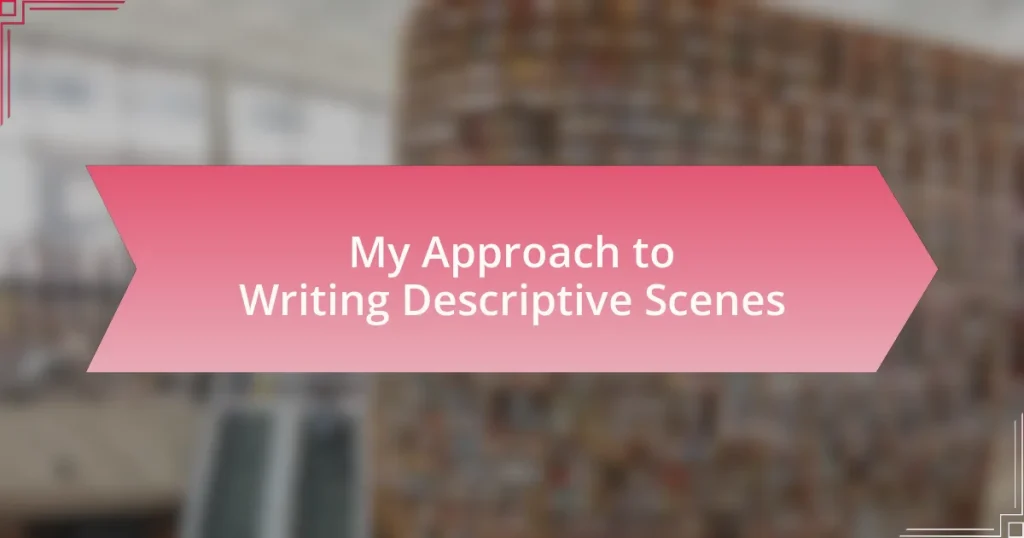Key takeaways:
- Descriptive writing enhances storytelling by using sensory details to evoke emotions and create vivid imagery.
- Effective descriptions are shaped by character perspectives, pacing, and the emotional connections they elicit from readers.
- Engaging scenes can be crafted by incorporating tension, character introspection, and all five senses to immerse readers fully.
- Personal experiences and observations enrich descriptive writing, allowing writers to convey authenticity and relatability in their narratives.
Author: Clara Whitfield
Bio: Clara Whitfield is a captivating storyteller and acclaimed author known for her rich, character-driven narratives that explore the complexities of human relationships. With a background in psychology and a passion for literature, Clara weaves intricate plots that resonate with readers on multiple levels. Her debut novel, “Echoes of the Heart,” received critical acclaim and was a finalist for several literary awards. When she’s not writing, Clara enjoys hiking in nature, experimenting in the kitchen, and engaging with her vibrant community of fellow writers. She resides in Portland, Oregon, where she draws inspiration from the lush surroundings and eclectic culture.
Understanding descriptive writing
Descriptive writing is all about painting vivid pictures with words. I remember the first time I tried to describe the simple act of rain falling; instead of saying “it rained,” I let myself linger on how the droplets danced on the pavement, glistening like tiny jewels. That moment made me realize that the details we choose can breathe life into our words and connect with the reader on a deeper level.
When I write a scene, I often ask myself: what do I want the reader to feel? A bustling market can be described in a bland way, but I prefer to pull in the sounds of vendors calling, the vibrant colors of fresh produce, and the earthy smell of spices wafting through the air. This approach not only creates a vivid image but also evokes emotions that draw the reader into the experience, making them feel as if they’re part of it.
The power of sensory language truly transforms descriptive writing. For instance, while recalling a sunset, I focus on how the sky blushes with hues of pink and orange, and how the crisp evening air hints at the approaching coolness. Engaging the senses can transport readers, making them feel the warmth, see the colors, and even reminisce about their own experiences under a sunset sky. Isn’t it fascinating how a few carefully chosen words can ignite such powerful memories and feelings?
Importance of descriptive scenes
Descriptive scenes serve as a bridge between the reader’s imagination and the writer’s intent. I often recall a moment where I meticulously described an old library, highlighting the musty scent of aging paper and the golden rays filtering through the dusty windows. By immersing readers in these details, I found that they not only visualize the scene but also form emotional connections with it. Isn’t that the magic of words?
The emotional impact of a well-crafted descriptive scene can’t be underestimated. I remember crafting a scene of a small child waiting for a parent to return. I described the child’s fidgeting hands and the anxious glances at the door, allowing readers to feel the tension and anticipation. This is what makes descriptive writing so crucial; it converts mere storytelling into an experience that resonates deeply with readers.
Moreover, descriptive scenes enhance the thematic depth of a piece. I once wrote about a crumbling house within a story of lost dreams. The peeling paint and broken windows became symbols of neglect and abandonment, amplifying the emotional weight of the narrative. Doesn’t it stand out how sensory details can reveal layers of meaning? By embedding such scenes within our writing, we guide readers to explore beyond the surface, encouraging them to engage with the underlying themes.
Elements of effective descriptions
When I think about effective descriptions, sensory detail immediately comes to mind. I vividly recall writing a scene set in a bustling market where I focused on the vibrant colors of fresh produce and the intoxicating aroma of spices. This not only painted a picture in the reader’s mind but also made them feel as though they were part of that lively atmosphere, enhancing their overall experience. Isn’t it fascinating how a single scent can ignite a plethora of memories and emotions?
Another crucial element is character perspective. Through my writing, I’ve noticed that conveying a scene from a character’s unique viewpoint can dramatically shift the reader’s perception. For instance, when I wrote about a rainy day, one character might find the rain soothing while another sees it as a gloomy reminder of lost opportunities. This contrast adds depth and complexity to the description, allowing readers to connect with different emotional responses. How have your characters shaped the scenes you write?
Lastly, consider the pacing of your descriptions. I’ve found that strategic pauses, where I linger on a detail, can amplify the emotional resonance of a moment. In a scene where a couple reunites after a long separation, allowing readers to soak in their trembling hands or teary eyes builds anticipation and heightens the emotional stakes. Isn’t it powerful how timing in writing can transform a simple moment into something monumental? Balancing these elements can truly elevate your descriptive prowess.
Techniques for vivid imagery
When crafting vivid imagery, I often turn to similes and metaphors. For example, while describing a sunset, I might say it was “like molten gold melting across the horizon.” This comparison not only creates a visual image but also evokes a sense of warmth and calm. How do you think different comparisons could enhance your own scene descriptions?
Another technique I find effective is incorporating movement and action. Instead of stating that a tree is tall, I would describe how it swayed gently in the wind, its branches dancing like arms celebrating freedom. This brings the scene to life, making it dynamic and engaging. Have you ever noticed how movement can transform a static image into a vivid experience?
Lastly, I always strive to use strong, descriptive verbs. Instead of saying someone walked, I might say they “strolled” or “skipped,” as these words carry different connotations and emotions. By paying attention to the verbs I choose, I can create a scene that resonates more deeply with the reader. Isn’t it interesting how a single word can change the entire mood of a description?
Personal experiences in writing
When I began writing descriptive scenes, I realized how deeply personal experience shaped my narrative style. One evening, while watching raindrops race down my window, I found myself captivated by their patterns. This moment led me to explore how I could translate such fleeting beauty into words. Have you ever felt that specific moment inspire your writing?
Throughout my journey, I discovered that incorporating my emotions into descriptions was transformative. I remember describing a park in autumn, where the crunch of leaves beneath my feet echoed my nostalgic thoughts. It wasn’t just the scenery; it was my personal connection to that time of year that made the scene resonate. How do your emotions influence the way you depict your world on the page?
Observing my surroundings has always informed my writing. Once, during a quiet walk, I paused to notice the impact of light filtering through tree branches. The interplay between shadow and sunlight sparked a scene about secrets hidden beneath the surface. Have you ever stopped to notice the little things that could tell an entire story? Embracing those moments enriches my writing and invites readers to see the world through my eyes.
Tips for crafting engaging scenes
When crafting engaging scenes, one technique I find invaluable is to engage all five senses. I vividly recall a visit to a bustling farmers’ market, where the sweet aroma of ripe strawberries wafted through the air, mingling with the earthy scent of fresh basil. The vibrant colors of produce and the buzz of chatter created an atmosphere that was almost palpable. Have you ever tried to immerse your readers in a moment by appealing to their senses? This approach not only paints a picture but also evokes emotions, making the scene come alive.
Another useful tip is to create tension and stakes within your scenes. I once wrote about a character standing on a cliff, her heart racing as she contemplated the leap into the unknown. The fear of the jump contrasted sharply with her yearning for freedom, which charged the moment with emotion. How does introducing conflict or uncertainty in your scenes enhance the reader’s engagement? This dynamic element can hold attention and keep readers on the edge of their seats, eager to see what unfolds next.
Lastly, character introspection can deepen the impact of your scenes. I remember a time I wrote a scene where a character gazed at a flickering candle, lost in her thoughts about a long-lost friend. By delving into her emotional state, I allowed readers to connect more profoundly with her experience. Have you considered how your characters’ inner lives can add layers to the settings you create? Bringing their reflections and emotions into focus can make even the most ordinary environments feel significant and relatable.
Examples of successful descriptive writing
When I think about successful descriptive writing, one example that stands out is a passage I crafted about a foggy morning in the countryside. The dense mist curled around the gnarled branches of ancient trees, muffling the sounds of chirping birds and creating an eerie stillness. As I wrote, I aimed to capture the feeling of isolation, evoking a sense that something—or someone—was hiding just out of sight. Have you ever noticed how atmosphere can dramatically shift a scene’s mood?
Another powerful example comes from a story where I described a bustling café during the lunch rush. The clatter of dishes and the scent of freshly ground coffee swirled together, creating an inviting chaos. I wanted readers to not only visualize the crowded tables but also feel the warmth of shared laughter and the comfort of familiar faces. Don’t you think that relatable environments resonate more deeply with readers, allowing them to step into the world you’ve created?
One of my favorite pieces of descriptive writing involves a summer evening by a lakeside. The sky transformed into a canvas of hues—pink, orange, and purple—as the sun dipped below the horizon. I painted this scene to evoke nostalgia, reminiscent of carefree childhood days spent splashing in the water. How often do we seek to capture fleeting moments that evoke a sense of longing or joy? It’s these intimate memories that enrich our writing and connect us with our readers on a profound level.















